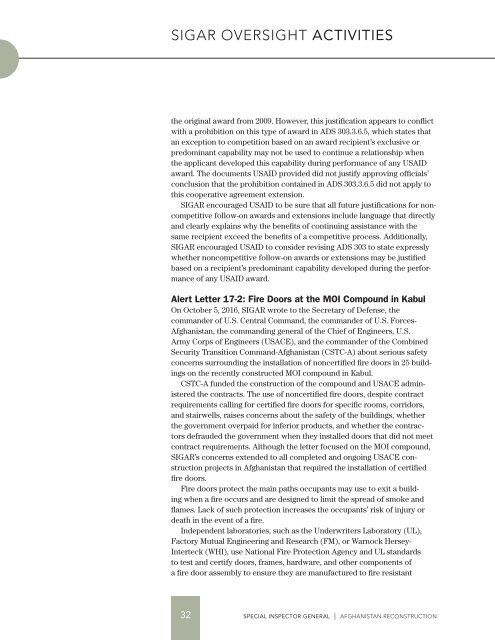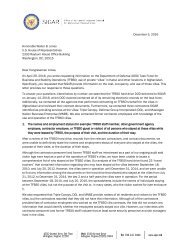SIGAR
2016-10-30qr
2016-10-30qr
You also want an ePaper? Increase the reach of your titles
YUMPU automatically turns print PDFs into web optimized ePapers that Google loves.
<strong>SIGAR</strong> OVERSIGHT ACTIVITIES<br />
the original award from 2009. However, this justification appears to conflict<br />
with a prohibition on this type of award in ADS 303.3.6.5, which states that<br />
an exception to competition based on an award recipient’s exclusive or<br />
predominant capability may not be used to continue a relationship when<br />
the applicant developed this capability during performance of any USAID<br />
award. The documents USAID provided did not justify approving officials’<br />
conclusion that the prohibition contained in ADS 303.3.6.5 did not apply to<br />
this cooperative agreement extension.<br />
<strong>SIGAR</strong> encouraged USAID to be sure that all future justifications for noncompetitive<br />
follow-on awards and extensions include language that directly<br />
and clearly explains why the benefits of continuing assistance with the<br />
same recipient exceed the benefits of a competitive process. Additionally,<br />
<strong>SIGAR</strong> encouraged USAID to consider revising ADS 303 to state expressly<br />
whether noncompetitive follow-on awards or extensions may be justified<br />
based on a recipient’s predominant capability developed during the performance<br />
of any USAID award.<br />
Alert Letter 17-2: Fire Doors at the MOI Compound in Kabul<br />
On October 5, 2016, <strong>SIGAR</strong> wrote to the Secretary of Defense, the<br />
commander of U.S. Central Command, the commander of U.S. Forces-<br />
Afghanistan, the commanding general of the Chief of Engineers, U.S.<br />
Army Corps of Engineers (USACE), and the commander of the Combined<br />
Security Transition Command-Afghanistan (CSTC-A) about serious safety<br />
concerns surrounding the installation of noncertified fire doors in 25 buildings<br />
on the recently constructed MOI compound in Kabul.<br />
CSTC-A funded the construction of the compound and USACE administered<br />
the contracts. The use of noncertified fire doors, despite contract<br />
requirements calling for certified fire doors for specific rooms, corridors,<br />
and stairwells, raises concerns about the safety of the buildings, whether<br />
the government overpaid for inferior products, and whether the contractors<br />
defrauded the government when they installed doors that did not meet<br />
contract requirements. Although the letter focused on the MOI compound,<br />
<strong>SIGAR</strong>’s concerns extended to all completed and ongoing USACE construction<br />
projects in Afghanistan that required the installation of certified<br />
fire doors.<br />
Fire doors protect the main paths occupants may use to exit a building<br />
when a fire occurs and are designed to limit the spread of smoke and<br />
flames. Lack of such protection increases the occupants’ risk of injury or<br />
death in the event of a fire.<br />
Independent laboratories, such as the Underwriters Laboratory (UL),<br />
Factory Mutual Engineering and Research (FM), or Warnock Hersey-<br />
Interteck (WHI), use National Fire Protection Agency and UL standards<br />
to test and certify doors, frames, hardware, and other components of<br />
a fire door assembly to ensure they are manufactured to fire resistant<br />
32<br />
SPECIAL INSPECTOR GENERAL I AFGHANISTAN RECONSTRUCTION




